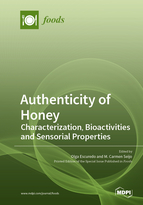Authenticity of Honey: Characterization, Bioactivities and Sensorial Properties
A special issue of Foods (ISSN 2304-8158). This special issue belongs to the section "Food Quality and Safety".
Deadline for manuscript submissions: closed (28 February 2022) | Viewed by 48215
Special Issue Editors
Interests: characterization of honeybee products; melissopalynology; unifloral honeys; physicochemical properties; sensorial characterization; healthy compounds
Special Issues, Collections and Topics in MDPI journals
Interests: characterization of honeybee products; melissopalynology; unifloral honeys; physicochemical properties; sensorial characterization; healthy compounds
Special Issues, Collections and Topics in MDPI journals
Special Issue Information
Dear Colleagues,
Honey is a very complex food to which many healthy properties are attributed. Some of these properties are highly related to the quality and botanical origin of the product. In this sense, identification of the properties of each honey type is one of the main concerns for consumers, beekeepers and researchers. Specifically, these studies are required to guarantee authenticity and to discriminate the unifloral honey. Improvement of this knowledge is directly related to the commercial value of honey. There are several techniques used to evaluate antioxidant and antimicrobial, physical and chemical characteristics, as well as the sensory characterization of honey.
This Special Issue aims to publish innovative research dealing with the authenticity, characterization, and biological properties of honey. We would like to invite researchers to submit unpublished manuscripts and review papers on the botanical profile, chemical composition, sensorial characteristics, functional properties, healthy compounds, and related subjects.
Prof. Olga Escuredo
Prof. M. Carmen Seijo
Guest Editors
Manuscript Submission Information
Manuscripts should be submitted online at www.mdpi.com by registering and logging in to this website. Once you are registered, click here to go to the submission form. Manuscripts can be submitted until the deadline. All submissions that pass pre-check are peer-reviewed. Accepted papers will be published continuously in the journal (as soon as accepted) and will be listed together on the special issue website. Research articles, review articles as well as short communications are invited. For planned papers, a title and short abstract (about 100 words) can be sent to the Editorial Office for announcement on this website.
Submitted manuscripts should not have been published previously, nor be under consideration for publication elsewhere (except conference proceedings papers). All manuscripts are thoroughly refereed through a single-blind peer-review process. A guide for authors and other relevant information for submission of manuscripts is available on the Instructions for Authors page. Foods is an international peer-reviewed open access semimonthly journal published by MDPI.
Please visit the Instructions for Authors page before submitting a manuscript. The Article Processing Charge (APC) for publication in this open access journal is 2900 CHF (Swiss Francs). Submitted papers should be well formatted and use good English. Authors may use MDPI's English editing service prior to publication or during author revisions.
Keywords
- botanical origin
- honey composition
- physicochemical characteristics
- sensorial attributes
- biological properties
- phytochemical markers
- unifloral honey







